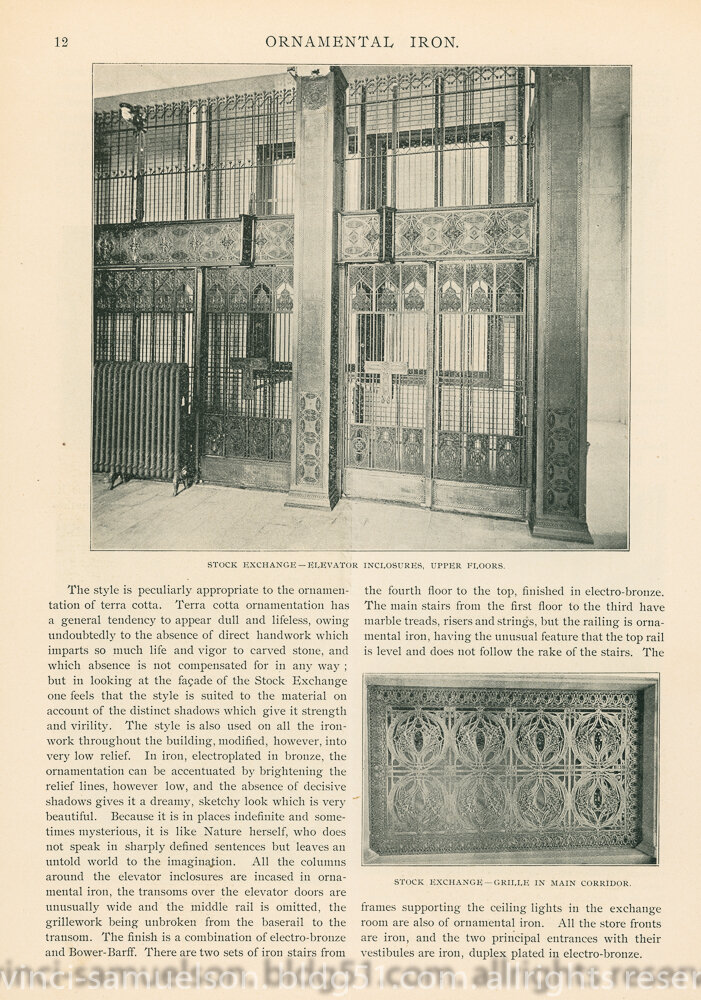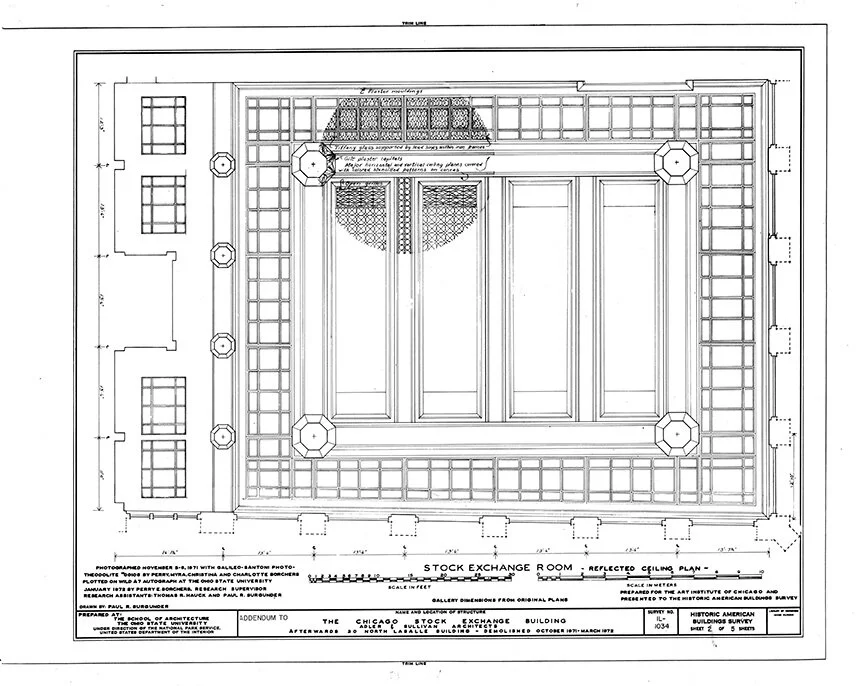The History of the Organic Design behind Louis Sullivan’s 1894 Chicago Stock Exchange Elevator Enclosures
Chicago Stock Exchange
One of Louis Sullivan’s most idealized buildings, the long-lost Stock Exchange historical value is still being cherished today — with sale of elevator enclosures and parts.
Demolished in 1972, The Chicago Stock Exchange was one of the most ground breaking and technologically advanced buildings of the late nineteenth century. From an engineering standpoint, the buildings assembly represents the emergence of the modern skyscraper with its steel frame and modern architectural features such as electric elevators and lighting throughout.
From a design stance the Exchange Building embodied Sullivans developing principles of organic ornament, and was emblematic of a new way of designing tall buildings forever marking a change American Architectural history.
These two impactful moments in engineering and design were brought together by the influential partnership between German-born engineer Danmar Adler and American-born Louis Sullivan.
Glass window panel from the firm of Adler and Sullivan
Over a 15-year period between 1880 and 1895, the Adler & Sullivan partnership revolutionized not only architecture with their inventiveness and creativity, but the way people and businesses lived and worked in modern cities.
Best known for designing the Prudential (Guaranty) Building in Buffalo, the Wainwright Building in St Louis and the Auditorium Building in Chicago. Louis Sullivan — the infamous mentor of Frank Lloyd Wright and the man who later would be nicknamed the “father of the modern skyscraper”, would go on to design hundreds of buildings across America in the years that followed — however few are as loved, or cherished as the long lost Chicago Stock Exchange.
Built 1893–1894, the steel-frame building was one of Dankmar Adler and Louis H. Sullivan’s most distinctive commercial structures. The quickly evolving building code along with technological advances in construction materials required an entirely new planning formula.
Constructed with the most modern and approved planning methodologies at the time, a thoroughly fireproof scheme was devised by the architectural duo giving rise to the second largest commission for the firm.
The Chicago Stock Exchange was also one of the earliest '‘elevator buildings’ the two designed. A nickname to distinguish it from other type buildings where tenants still had to walk up the stairs, the interior was organized around a central elevator lobby and an open vertical core that cut through all floors.
Completed in 1894 at a total cost of $1,131,555.16., the stock exchange contained 13 storeys complete with all the latest architectural features. Ten large elevators equipped with automatic signals provided superior service, mens washrooms supplied with hot and cold water on the main floor provided the highest convenience at the time, and electric lighting throughout the buildings interior spaces culminated in one of the most technologically advanced offices in the world.
The entrances to the building is from the sidewalk level without tenants having to a step up due to an interesting feature where the 1st floor is expressed as the basement the on the exterior of the building. Both the Washington and LaSalle street entrances lead directly to two batteries of five elevators, all of which will ran to the top of the building with the second and third floors measuring as the main arcade and lobby area.
The interior of the building was decorated with lavish organic designs inspired by the flora and fauna of the prairie landscape exemplary of Sullivans signature organic style. Sullivan believed that all architectural ornament should be derived from nature unlike other American Architects who were still employing the Neo-Classical or Beaux-Arts Style derived from European architecture. As his design work matured, he employed natural motifs in a more abstract and symbolic manner expressing the underlying geometry of all natural forms.
Sullivan associated ovals with seeds—symbols of life. His powerful use of this form in the ornamentation of the Chicago Stock Exchange Building can be seen on this elevator grille and on the building’s staircases, which were installed in the American Wing in 1980.
This elevator surround is a fine example of the remarkable design and quality of their most important building.
elevators during a past era when cabs and corridor walls were openwork metal rather than enclosed boxes. Sullivan intended for the elevator screens to not only be experienced when walking in the corridors on foot, but also to be seen in rapid succession while riding in a fast-moving openwork elevator cab. Rapid vertical movement was a new sensation in architectural spatial perception, and Sullivan made it a powerful experience with this design.
As with the forces of nature that inspired him, architect Louis H. Sullivan's work is about all parts relating to the whole. This concept is eloquently demonstrated in this assemblage of the corridor elevator walls of the Chicago Stock Exchange Building, a significant Adler & Sullivan skyscraper completed in 1894 and tragically demolished after a heated preservation battle in 1972. Salvage of decorative elements of the building's elevators was erratic, with little consideration given to preserving entire assemblies to represent Sullivan's all-inclusive design concept. Individual elements, such as the delicate strap metal screens, the copper-plated ornamental iron lintels, and distinctive "T" medallions are typically offered for sale individually.
The overall composition is Louis H. Sullivan at his best. Delicate strap metal grilles are unique among Sullivan's designs, representing what has been described as a mechanistic interpretation suggesting bursting buds of nature. Vibrant horizontal iron lintels are a fluid ornamental pattern that are integral with metal surface itself and inseparably mends geometric and natural forms.
A framework of copper-plated ornamental cast iron creates a striking, yet harmonious contrast to the delicate openwork strap metal screens, finished in a dull grey-black finish. All work together as a symbolic abstraction. Modular geometry inherent in architecture mends with organic natural forms reflecting the powers of human creation—the essence of Sullivan's architectural philosophy. A framework of copper-plated ornamental cast iron creates a striking, yet harmonious contrast to the delicate openwork strap metal screens, finished in a dull grey-black finish. All work together as a symbolic abstraction. Modular geometry inherent in architecture mends with organic natural forms reflecting the powers of human creation—the essence of Sullivan's architectural philosophy. A framework of copper-plated ornamental cast iron creates a striking, yet harmonious contrast to the delicate openwork strap metal screens, finished in a dull grey-black finish. All work together as a symbolic abstraction. Modular geometry inherent in architecture mends with organic natural forms reflecting the powers of human creation—the essence of Sullivan's architectural philosophy.
The ironwork elevators that Louis Sullivan designed for the Chicago Stock Exchange, completed in 1894, exemplify this idea. One of these elevators from the now demolished building that stood at LaSalle and Washington Streets was reassembled for a recent exhibit at the Chicago Historical Society entitled
''Louis Sullivan: The Function of Ornament.''
One of the most complete assemblages of the elevator surround from Adler and Sullivan's Chicago Stock Exchange to be offered at auction.
In themselves, these isolated elements have become highly sought-after icons of Louis H. Sullivan's contributions to architecture and the decorative arts. But in this instance, individual component parts are assembled to create a representation of the entire design concept, demonstrating how all relate the whole as an organically-unified composition.
A framework of copper-plated ornamental cast iron creates a striking, yet harmonious contrast to the delicate openwork strap metal screens, finished in a dull grey-black finish.
Aliquam et molestie eros, nec sollicitudin nisi. Aliquam at nunc vehicula, vestibulum mi finibus, vulputate ante. Lorem ipsum dolor sit amet, consectetur adipiscing elit. Nullam at leo sit amet metus dictum bibendum quis et ipsum. Mauris in aliquet lectus. Nullam ut elit a elit mattis varius. Donec rutrum orci nulla. Vivamus quam urna, pharetra non interdum sit amet, posuere nec leo. Aliquam nec tellus quis arcu ornare congue. Vestibulum et efficitur nibh. Fusce elementum fermentum hendrerit. In sem elit, tincidunt non est eget, varius malesuada urna.
Vivamus venenatis lectus at magna imperdiet lobortis. Donec vestibulum massa non risus mattis mollis. Vivamus viverra id nunc ut cursus. Aliquam non odio quis lacus suscipit porta. Maecenas elit velit, viverra eget purus vitae, sagittis blandit mi. Praesent non massa nec orci consectetur eleifend. Pellentesque bibendum ligula tellus. Nunc eget rhoncus sem. Vestibulum quis sagittis ante. Etiam hendrerit suscipit neque id aliquam. Suspendisse elementum egestas velit. Mauris dictum quis eros eu mattis. Interdum et malesuada fames ac ante ipsum primis in faucibus.
Chicago Stock Exchange Building, c. 1894
Aliquam et molestie eros, nec sollicitudin nisi. Aliquam at nunc vehicula, vestibulum mi finibus, vulputate ante. Lorem ipsum dolor sit amet, consectetur adipiscing elit. Nullam at leo sit amet metus dictum bibendum quis et ipsum. Mauris in aliquet lectus. Nullam ut elit a elit mattis varius. Donec rutrum orci nulla. Vivamus quam urna, pharetra non interdum sit amet, posuere nec leo. Aliquam nec tellus quis arcu ornare congue. Vestibulum et efficitur nibh. Fusce elementum fermentum hendrerit. In sem elit, tincidunt non est eget, varius malesuada urna.
Vivamus venenatis lectus at magna imperdiet lobortis. Donec vestibulum massa non risus mattis mollis. Vivamus viverra id nunc ut cursus. Aliquam non odio quis lacus suscipit porta. Maecenas elit velit, viverra eget purus vitae, sagittis blandit mi. Praesent non massa nec orci consectetur eleifend. Pellentesque bibendum ligula tellus. Nunc eget rhoncus sem. Vestibulum quis sagittis ante. Etiam hendrerit suscipit neque id aliquam. Suspendisse elementum egestas velit. Mauris dictum quis eros eu mattis. Interdum et malesuada fames ac ante ipsum primis in faucibus.
All elements were manufactured to Sullivan's custom designs by the Winslow Brothers Company in Chicago. Winslow Brothers was Sullivan's longtime preferred fabricator for his ornamental metalwork, based on their ability to create art-grade elements in the mass production necessary for large-scale architectural projects.
Lorem ipsum dolor sit amet, consectetur adipiscing elit. Phasellus nisl ante, viverra ac vestibulum vel, iaculis sit amet diam. Mauris quis quam et mi dictum vulputate nec ut urna. Donec semper lobortis lorem, in ultricies dolor pulvinar sit amet. Duis a lorem eu tellus vehicula molestie. Sed vel sagittis lectus. Proin venenatis, sapien quis dapibus interdum, odio ipsum auctor mi, id venenatis sapien tellus eget justo. Praesent ultrices consectetur augue sed scelerisque. Aenean porttitor nisl mi, sit amet consequat augue cursus sed. Suspendisse tempor justo sit amet porttitor dignissim.
Aliquam et molestie eros, nec sollicitudin nisi. Aliquam at nunc vehicula, vestibulum mi finibus, vulputate ante. Lorem ipsum dolor sit amet, consectetur adipiscing elit. Nullam at leo sit amet metus dictum bibendum quis et ipsum. Mauris in aliquet lectus. Nullam ut elit a elit mattis varius. Donec rutrum orci nulla. Vivamus quam urna, pharetra non interdum sit amet, posuere nec leo. Aliquam nec tellus quis arcu ornare congue. Vestibulum et efficitur nibh. Fusce elementum fermentum hendrerit. In sem elit, tincidunt non est eget, varius malesuada urna.
Vivamus venenatis lectus at magna imperdiet lobortis. Donec vestibulum massa non risus mattis mollis. Vivamus viverra id nunc ut cursus. Aliquam non odio quis lacus suscipit porta. Maecenas elit velit, viverra eget purus vitae, sagittis blandit mi. Praesent non massa nec orci consectetur eleifend. Pellentesque bibendum ligula tellus. Nunc eget rhoncus sem. Vestibulum quis sagittis ante. Etiam hendrerit suscipit neque id aliquam. Suspendisse elementum egestas velit. Mauris dictum quis eros eu mattis. Interdum et malesuada fames ac ante ipsum primis in faucibus.
















